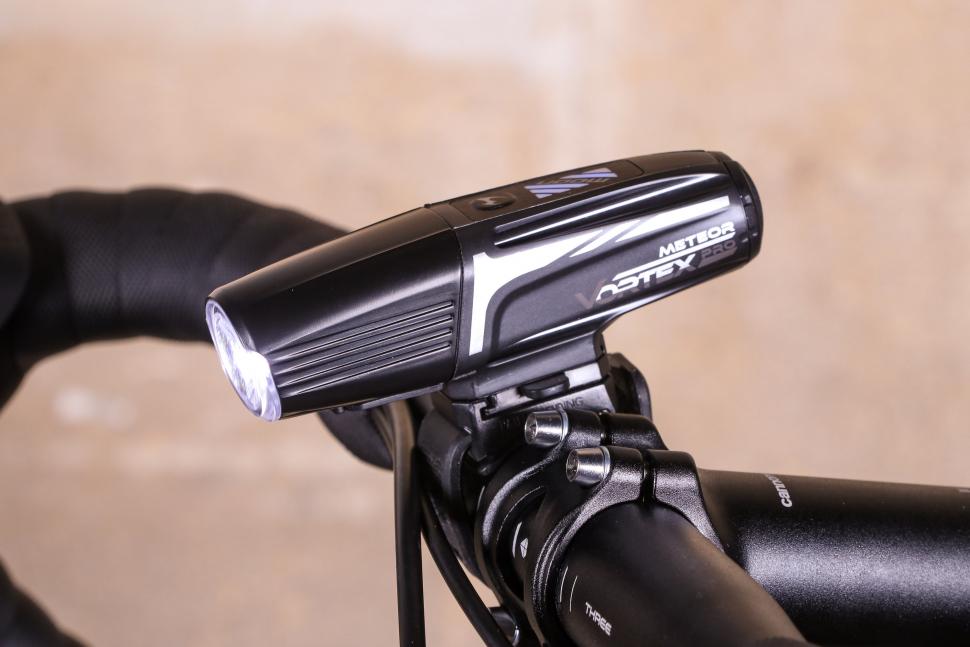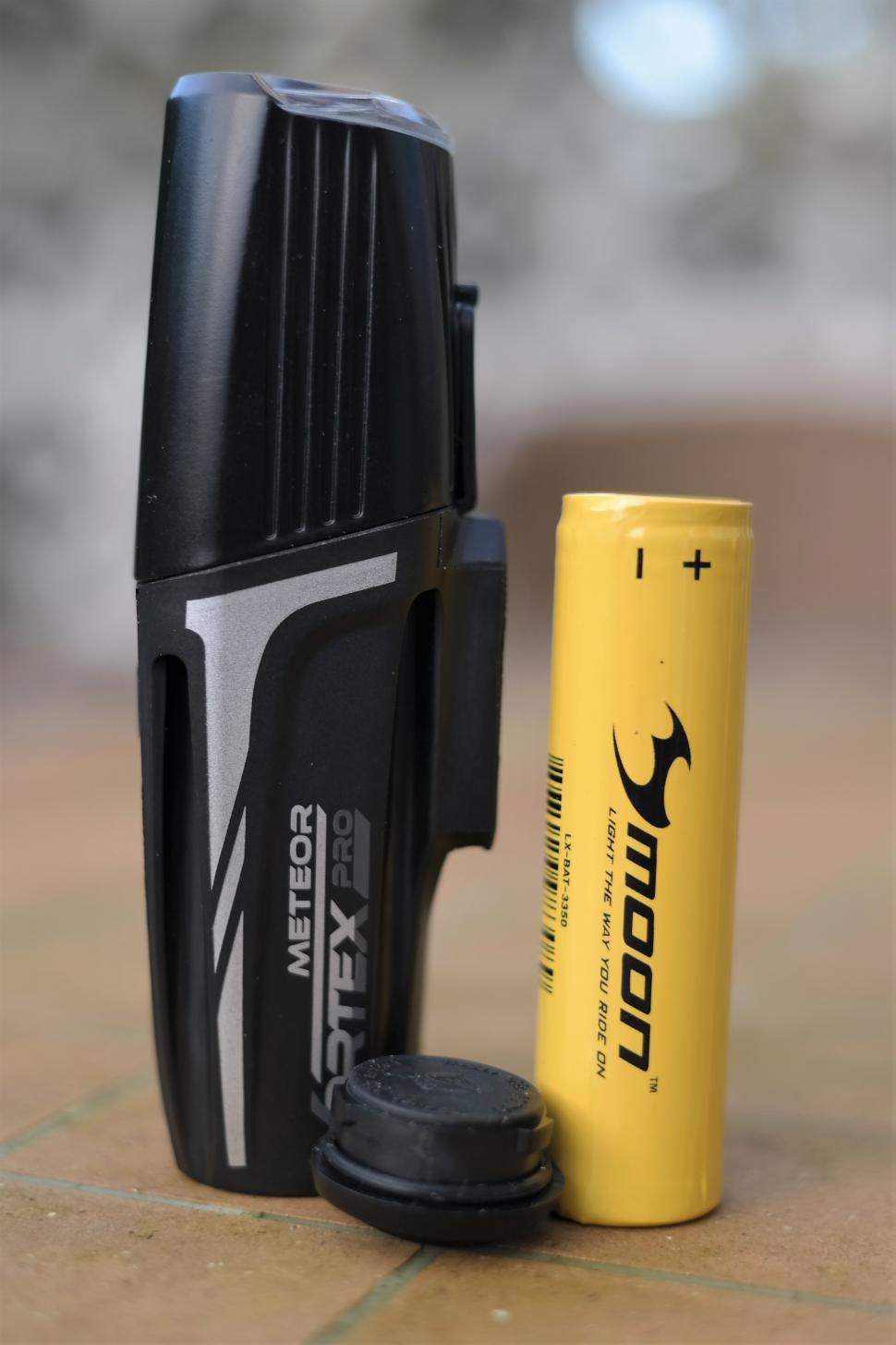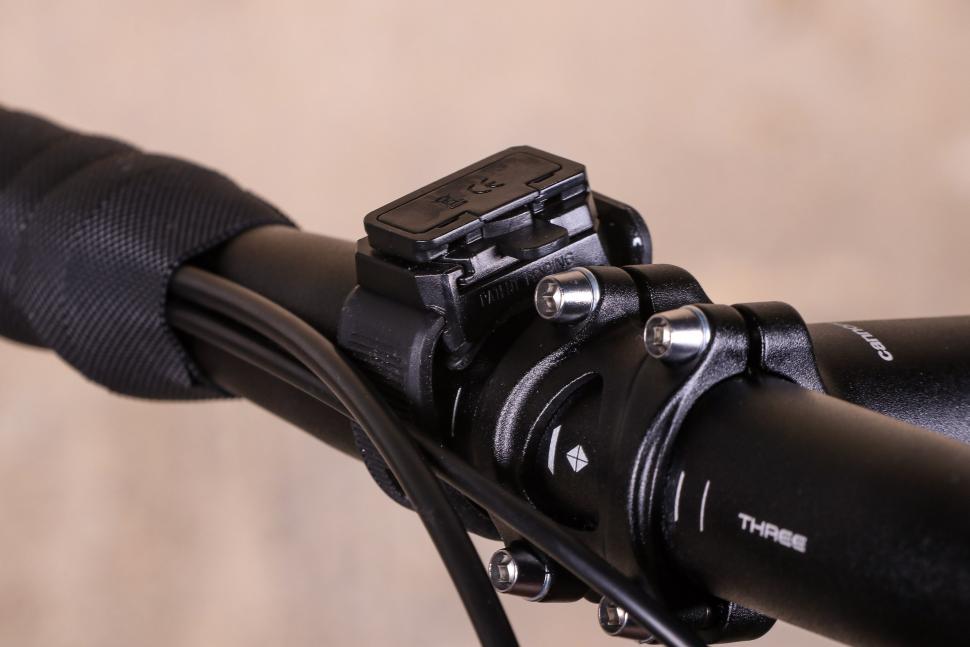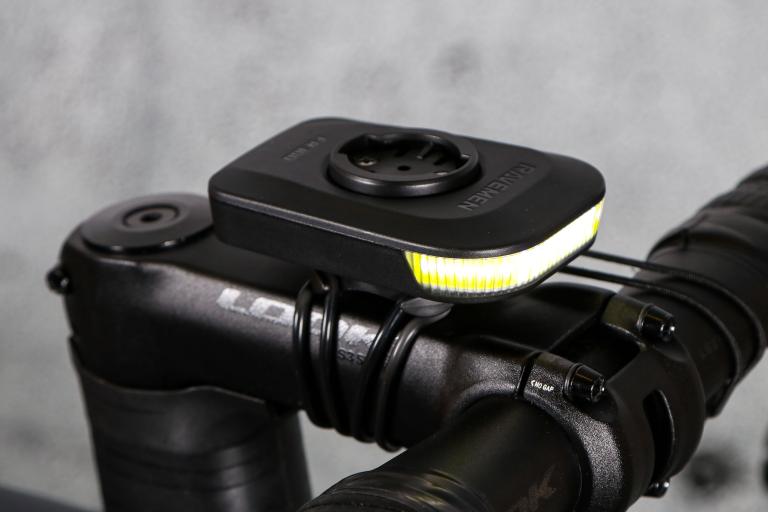- News
- Reviews
- Bikes
- Accessories
- Accessories - misc
- Computer mounts
- Bags
- Bar ends
- Bike bags & cases
- Bottle cages
- Bottles
- Cameras
- Car racks
- Child seats
- Computers
- Glasses
- GPS units
- Helmets
- Lights - front
- Lights - rear
- Lights - sets
- Locks
- Mirrors
- Mudguards
- Racks
- Pumps & CO2 inflators
- Puncture kits
- Reflectives
- Smart watches
- Stands and racks
- Trailers
- Clothing
- Components
- Bar tape & grips
- Bottom brackets
- Brake & gear cables
- Brake & STI levers
- Brake pads & spares
- Brakes
- Cassettes & freewheels
- Chains
- Chainsets & chainrings
- Derailleurs - front
- Derailleurs - rear
- Forks
- Gear levers & shifters
- Groupsets
- Handlebars & extensions
- Headsets
- Hubs
- Inner tubes
- Pedals
- Quick releases & skewers
- Saddles
- Seatposts
- Stems
- Wheels
- Tyres
- Health, fitness and nutrition
- Tools and workshop
- Miscellaneous
- Tubeless valves
- Buyers Guides
- Features
- Forum
- Recommends
- Podcast
review
£79.99
VERDICT:
Good, solid front light for seeing with and being seen, day and night
Weight:
169g
Contact:
At road.cc every product is thoroughly tested for as long as it takes to get a proper insight into how well it works. Our reviewers are experienced cyclists that we trust to be objective. While we strive to ensure that opinions expressed are backed up by facts, reviews are by their nature an informed opinion, not a definitive verdict. We don't intentionally try to break anything (except locks) but we do try to look for weak points in any design. The overall score is not just an average of the other scores: it reflects both a product's function and value – with value determined by how a product compares with items of similar spec, quality, and price.
What the road.cc scores meanGood scores are more common than bad, because fortunately good products are more common than bad.
- Exceptional
- Excellent
- Very Good
- Good
- Quite good
- Average
- Not so good
- Poor
- Bad
- Appalling
The Moon Meteor Vortex Pro is a nicely executed, compact light with settings for most occasions, from seeing where you're going on pitch black lanes, to being seen in built-up areas and during the day. It also offers the ability to program your own if the default settings don't suit. Run-times are reasonable, and a replaceable battery enables longer rides at full whack.
- Pros: Good run-times, replaceable battery, decent mounts, programmable modes
- Cons: Quality of output tempered by torch type lens
Specification
This year's model has fewer modes than the one Stu tested in 2018, and Boost has gone up from 900 to 1,100 lumens, which should suit night owls like me who spend much of our winter nights tackling pitch black lanes.
There are two more steady modes, 750 lumens and 120 lumens, plus three flashing (one for daylight) and an SOS, which is designated for emergencies only.
However, the light also features a Variable Lumen System – VLS. This allows you to set the power output of any of the modes other than Boost or SOS within a range of 20-750 lumens. It took me a few attempts to get the hang of it – possibly I was overcomplicating things, Dave in the office found it very easy to configure from the off – but its benefits grew on me.
Otherwise, specification is very similar to its 900-lumen predecessor: a CNC machined shell, Cree XM-L2 LED diode, and replaceable 3.63V 3350mAh battery, which means a dying cell doesn't render the light bin-fodder – plus you could always buy a second and carry that, just in case or for really long rides.
The light has an IPX4 rating for weatherproofing, which means it's splashproof; you could put a sliver of silicone grease on the charge port cover and battery compartment if you wanted, but I've had no issues even in torrential rain.
VLS
The default settings are listed in the Test Report below, but VLS means you can change the output of the 750 and 120-lumen constant modes and the three flash modes, Flash 1 (100 lumens), Steady Flash (200 lumens) and Day Flash (400 lumens). You can set these to anywhere between 20 and 750 lumens, by doing this:
1. Turn on the light.
2. Choose your mode.
3. Hold the button to select VLS mode and keep holding as it scrolls up and down until it's the brightness you want...
4. Let go.
This is then committed to the light's memory. This allows you to tailor the light to suit your environment. To restore the factory preset you simply remove the battery, depress the power button for a second or two, and then reassemble.
Switch
The switch is a small button type with a relatively soft action but features a locking mode to prevent unwanted power-ups. Simply turn the light off, hold the switch for six seconds and it will lock – denoted by a clear blue line. To unlock, again hold continuously for six seconds.
Otherwise, press once to power up, then subsequent single prods change mode, double for boost. Depress the button for a few seconds to switch to the flashing modes.
The memory function saves faff, although changing modes mid-ride is simplest with the included wired remote. Tidy folks could run the wire beneath their bar tape.
Mounts
The mounts – bar and helmet – are pleasingly solid. The watch strap type bar mount offers secure tenure to standard, oversized and aero patterns. The webbed helmet strap has also been a good fit with road, trail and mountain bike-influenced commuter/touring types.
Bike or helmet-mounted, there's some very minor vibration when thundering along an unmade road, but nothing in the way of slippage.
Performance
Overall performance, taking into account price and specification, is very favourable. Lens and reflector quality is good rather than great, but with the full 1,100 lumens on tap I've had no problems picking out potholes, ruts and glass from about 10 metres, riding at 22mph on the darkest roads.
Tackling a 1-in-7 descent at 30mph required greater concentration, but again leaves, dung, potholes and kamikaze rabbits were easily spotted/avoided.
There's a good spread of light too, alerting oncoming traffic at 30 metres or so.
Run-times are cited as 2hrs 15mins and I've come within 10 minutes of this, in temperatures ranging between 2 and 6°C. Given the battery type, I wasn't surprised to lose a few minutes when temperatures dipped below zero, but the charge life indicator clues you in pretty well, allowing time to prod down.
When it comes to recharging, bargain on four hours, zero to hero, longer if refuelling from a PC/similar device. Solid blue denotes fully fuelled.
The next brightest mode, 750 lumens, is still good enough for dark roads and I've slipped to this, extending battery life, without trading too much output. Helmet-mounted, paired with higher power dynamo/rechargeable bar-mounted systems, it's pretty effective and brilliant for tackling punctures and similar mechanicals along very dark roads or trails. I wasn't overly conscious of its weight either. I found it came up about 10 minutes short of the claimed 3hr run-time.
I was a little sceptical of the 120-lumen default setting – yes, it's good enough for shared use town paths perhaps, and useful for reading road signs, rummaging in panniers and tending to a mechanical, but around town I felt more comfortable with the 200-lumen Steady Flash.
With street lighting there's enough power for spotting hazards, while the distinctive pulsing tempo signals your presence to around 60 metres on a clear night. I've cruised past the 30-hour mark and it's reckoned good for 52 hours.
The 400-lumen Day Flash has also pleased me, with more than enough punch on murky open roads without being aggressive or drowned out on the high street scramble. Friends reckoned they could pick out its flashing tempo at 55-60 metres. Some considered it borderline antisocial on group rides, and in those instances I've gone for the 200-lumen option.
Moon reckons 129 hours for the Day Flash, and I've come nowhere near calling its bluff. Nor, thankfully, have I needed the SOS.
Value
A penny shy of £80, the Meteor Vortex Pro offers solid value for money. It's £10 more than Lezyne's 1,000-lumen Lite Drive 1000XL, but the Lezyne's mode sequences and bar mount would merit revision.
> Buyer's Guide: The best 2019/2020 front lights for cycling
It's the same price as Giant's Recon HL900, and £30 cheaper than Cateye's AMPP 1100, which offers a good performance but shorter run-times.
Conclusion
In my opinion, the Meteor Vortex Pro is a solidly made, affordable light with a good choice of modes and outputs, plus the ability to set five of them to suit your own requirements. On paper, the weather sealing could be better but this hasn't been an issue during testing, and a replaceable battery is a definite plus.
Verdict
Good, solid front light for seeing with and being seen, day and night
road.cc test report
Make and model: Moon Vortex Pro Front Light
Size tested: 1100 lumens
Tell us what the light is for, and who it's aimed at. What do the manufacturers say about it? How does that compare to your own feelings about it?
Moon doesn't state what it's for; I would describe it as a very versatile torch-type light for most types of road-biased riding.
Tell us some more about the technical aspects of the light?
Moon lists:
Features
New control button
Variable Lumen System VLS
Lock system
1 CREE XM-L2 high brightness LED
CNC Aluminum heat sink light cap
Mode memory function
Day flash mode
Boost mode, 2 steady modes, 3 flashing modes, SOS mode
Quick release rechargeable Lithium ion battery (3.63V 3350 mAh)
Quick release universal bracket (fits all round and AERO style bars)
Mode indicator
Low battery, charging and fully charged indicator
Automatic fully charged cut-off system
High precision optical lens
Side visibility
Recharge time (2A:3:30hrs / 0.5A:5:30hrs)
Water Resistance (IPX 4)
Size (W x D x H): 31 x 31 x 111.5mm
Weight: 120g / Packing & Package: 0.1Kg
Contents
METEOR VORTEX PRO
RB-25 (Handlebar bracket)
RB-16 (Helmet bracket)
USB-WP (Water resistant USB cable)
LX-BAT-3350 (LG Lithium ion battery 3350 mAh)
USB-RM-350 (USB remote control 350 mm)
LX-BC (Magnetic Cover)
Optional accessories
RB-28 (GoPro mount adapter)
XP-USC (Wall charger)
Mode Lumen (default) Runtime (default) VLS Lumen Runtime
BOOST 1100 2:15 - -
MODE 1 750 3:00 750 - 20 3:00 - 120:00
MODE 2 120 23:00 750 - 20 3:00 - 120:00
FL 1 100 98:00 750 - 20 18:00 - 370:00
Steady FL 200 52:00 750 - 20 24:00 - 96:00
Day FL 400 129:00 750 - 20 95:00 - 630:00
SOS - 111:00 - -
*Use the SOS sign for real emergency only!
Rate the light for quality of construction:
8/10
Generally very solid, thanks in no small part to the aluminium body.
Rate the light for design and ease of use. How simple was the light to use?
8/10
Generally intuitive. Wired remote is also a nice touch and makes for easy mid-ride changes.
Rate the light for the design and usability of the clamping system/s
8/10
Bar mount seems universally reliable with all shapes and diameters. Helmet mount good rather than great, but certainly better than some OEM types I've used.
Rate the light for waterproofing. How did it stand up to the elements?
8/10
Hasn't missed a beat, despite prolonged exposure to torrential rain and being left in situ during sudsy bucket bike washing.
Rate the light for battery life. How long did it last? How long did it take to recharge?
7/10
Run-times are favourable, and there are ample modes to suit most road biased conditions. Zero to hero charge times are slightly pedestrian but nothing unusual by genre standards. The replaceable battery is a plus, since you can carry a spare and switch to that, on longer rides or forgetful moments.
Rate the light for performance:
8/10
Enough wallop for dark roads, and sensible number of modes which you can tailor for a decent blend of output and economy.
Rate the light for durability:
7/10
Solidly built and no problems to date. However, I'd be tempted to add a precautionary lick of Vaseline to the battery contacts if you're regularly riding in foul weather.
Rate the light for weight:
7/10
Feels solid, but not hefty atop a helmet.
Rate the light for value:
6/10
It's gone up in price since the last iteration – but so has the Boost output. It's the same price as Giant's Recon HL900, and £30 less than Cateye's AMPP 1100.
Tell us how the light performed overall when used for its designed purpose
Overall, the Moon Meteor Vortex is a solid choice for those seeking to tackle a wide range of road biased riding The VLS (Variable Lumen System) allows some customisation so you can tailor modes to your needs, run-times are favourable and I like the option of being able to purchase spare/replacement batteries.
Tell us what you particularly liked about the light
Compact design, solid build, a sensible range of default modes and favourable run-times.
Tell us what you particularly disliked about the light
Mastering the VLS system took me a few attempts... useful once you've got it sussed, though.
Did you enjoy using the light? Yes
Would you consider buying the light? Yes, for a lightweight commuter/winter trainer.
Would you recommend the light to a friend? Yes.
Use this box to explain your overall score
Overall, it's a decent all-rounder for those who want to ride in a wide variety of contexts. The ability to program your preferred output and to carry spare batteries are definite pluses. In some respects the lens could be better, likewise waterproofing, but in fairness both are up to the job.
About the tester
Age: 46
I usually ride: Rough Stuff Tourer Based around 4130 Univega mtb Frameset My best bike is: 1955 Holdsworth Road Path and several others including cross & traditional road
I've been riding for: Over 20 years I ride: Most days I would class myself as: Experienced
I regularly do the following types of riding: cyclo-cross, commuting, touring, fixed/singlespeed, mountain biking
Shaun Audane is a freelance writer/product tester with over twenty-eight years riding experience, the last twelve (120,000 miles) spent putting bikes and kit through their paces for a variety of publications. Previous generations of his family worked at manufacturing's sharp end, thus Shaun can weld, has a sound understanding of frame building practice and a preference for steel or titanium framesets.
Citing Richard Ballantine and an Au pair as his earliest cycling influences, he is presently writing a cycling book with particular focus upon women, families and disabled audiences (Having been a registered care manager and coached children at Herne Hill Velodrome in earlier careers)
Latest Comments
- GMBasix 57 min 30 sec ago
There are several cycle awareness courses around the country. They may not address psychology in detail, but they take drivers out on bikes. They...
- chrisonabike 1 hour 14 min ago
Why leave yourself open to the problem in the first place? No windows, no draughty windows.
- chrisonabike 1 hour 15 min ago
Yup - although as a more "distributed" / low cost kind of "good" (which the public purse pays towards) cycling will likely always be susceptible to...
- quiff 2 hours 22 min ago
I'm sure they'd ask Lime to do that too. Come and collect your bikes and my neighbour - they're in pieces.
- brooksby 2 hours 28 min ago
Ireland seems to have a lot of problems with their cycle lanes… Almost as many as England
- quiff 2 hours 48 min ago
Fair point - I was restricting myself to pedal bikes. As I've never spent that kind of money on anything though (mortgage doesn't count), it's kind...
- brooksby 3 hours 50 min ago
And finally: I wonder how many of the "more than 3,000" signatures on that petition are actually locals, who live or work there (and are not just...
- Doug_D 5 hours 26 min ago
Another book suggestion - I can highly recommend "Lost Summers and Half-Forgotten Afternoons: A Mint Sauce collection" - a beautifully presented...
- mdavidford 7 hours 17 min ago
I think you're missing an opportunity to pack even more tech into it - add accelerometers that can detect whether they're pedalling or stepping....
















Add new comment
10 comments
You've still failed to tell us how it can have a narrow beam and blind oncoming traffic - do you ride on the wrong side of the road?
Unassailable logic. Because, of course, nobody ever rides on bike paths, canal towpaths, single-track country roads, or city streets reduced to effectively one lane by cars parked either side. No one filters past queues of stationary vehicles or moves to the middle of the road to make a right turn. Traffic calming chicanes and streets which are one-way except for a bike lane in the opposite direction don't exist. Everyone's commutes are exclusively along wide, straight roads, without any blind bends where suddenly being dazzled could be especially dangerous.
I find moon lights really good too. Point them down at the road. It's not rocket science is it.
I have used Moon lights for years, the very focussed beam is ideal for road use, I dont want half of my light output being used to light the grass verge either side of the road where I will never put a wheel, I want the light up ahead to see what is on the road and where the road goes. My LX760 is the best light I have owned, I have tried more expensive makes and brighter lights but keep coming back to the 760 which throws enough light straight ahead for 35mph descents on unlit lanes and which doesnt annoy drivers which other lights with greater spread of light do.
With this type of light, when pointed down so as not to blind anyone, you're not actually seeing the entire road ahead of you, you're seeing a small circle determined by whatever your front wheel is pointing at at that particular instant. Perfect if all the roads you ride on are straight as an arrow. Additionally, unless you point it down and in doing so create a hotspot that will further reduce your night vision, half of the output is blazed away uselessly, except that it annoys traffic. There's a lot of sense in using one of the StVzO-compliant bike lights.
I guess we'll agree to disagree, I ride half of the year when it's dark (very early commute), also tried a lot of brands and won't use anything but a headlight with a flattened beam with some lateral spread.
I forgot: it does have one good point: the mounting system that can deal with aero-bars.
Where does it say in my post that I point it down? I aim it up the road to see where I am going and where the road goes. When did you use this particular light that you are running down, I would suspect that you have never tried it which, if that is the case, would make your points meaningless.
My experience of StVzO lights wasn't very good, great for lighting up grass verges but pretty poor at throwing a beam far enough ahead.
I'd like to see you point that thing up as you describe and not blind approaching traffic. Of course, if you don't care about that then my argument becomes moot. I didn't try this particular light (if someone will lend me one to try I'll happily do so) but if the beam comparison engine on this site is anything to go by then it's very similar to a number of other lights that I did try and that for me simply didn't work. You don't say which StVZO-lights you tried but it's technically impossible that a properly set up compliant light would perform as you describe (illuminating the borders, not the road) as the illumination levels at various distances and the cut-off points are defined in the technical standard.
Marginal waterproofing, el cheapo construction and a very focussed and round beam that will make it appear as if you're riding through a narrow, dark tunnel and indeed blind incoming traffic. Forgive me for not seeing a lot of value.
If it is a narrow beam, how is it blinding oncoming traffic?
And blinding them at 15 metres.